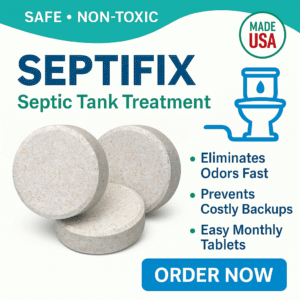When you live in an area without access to a municipal sewer line, a septic system is essential. Septic systems safely manage household wastewater, treating and dispersing it underground. But not all septic systems are created equal—different soil conditions, lot sizes, and household needs require different solutions. In this guide, we’ll cover the most common types of septic systems, their pros and cons, and what you should know before installing one.
Quick Picks: Most Popular Septic System Types
- Best Overall: Conventional Septic System – Affordable, reliable, and widely used for most households.
- Best for Small Lots: Aerobic Treatment Unit (ATU) – Compact design that treats wastewater with oxygen.
- Best Premium: Mound Septic System – Designed for properties with poor or shallow soil conditions.
Buyer’s Guide: How to Choose a Septic System
Septic systems are long-term investments, so choosing the right one is critical. Here are some key factors to consider:
- Soil Type: Sandy soils allow for faster absorption, while clay soils may require specialized systems like mounds.
- Lot Size: Small lots often need advanced treatment systems due to space limitations.
- Household Size: Larger families require bigger systems with higher flow capacity.
- Budget: Conventional systems are more affordable, while advanced systems like ATUs cost more but work in challenging conditions.
- Local Regulations: Always check local codes before installation—some areas require specific system types.
- Maintenance Needs: Conventional systems are low-maintenance, while ATUs and mound systems require regular servicing.
Detailed Septic System Reviews
1. Conventional Septic System
Who It’s For: Homeowners with good soil drainage and sufficient land space.
- Uses a septic tank and a drain field (leach field)
- Affordable installation compared to alternatives
- Minimal maintenance requirements
Pros:
- Cost-effective
- Long-lasting with proper care
- Simple design
Cons:
- Not suitable for clay or shallow soils
- Requires larger lot sizes
Final Verdict: The most common and affordable system for homes with good soil conditions. Learn more here
2. Aerobic Treatment Unit (ATU)
Who It’s For: Homeowners with small lots or poor soil who need advanced treatment.
- Uses oxygen to break down waste faster
- Produces cleaner effluent than conventional systems
- Can be installed in tighter spaces
Pros:
- Compact footprint
- Cleaner discharge water
- Works in challenging soil conditions
Cons:
- More expensive upfront
- Requires ongoing maintenance and electricity
Final Verdict: A smart choice for properties with limited space or tough soil. Check availability
3. Mound Septic System
Who It’s For: Homes with shallow bedrock, high groundwater, or poor soil absorption.
- Wastewater pumped into an above-ground sand “mound” for filtration
- Custom engineered for tough soil environments
- Ideal for rural properties with poor drainage
Pros:
- Works in poor soil and high water table areas
- Provides reliable treatment where conventional systems fail
- Long lifespan when maintained
Cons:
- High installation cost
- Takes up more yard space
Final Verdict: Best for difficult soil conditions where standard systems aren’t possible. Check pricing
4. Chamber Septic System
Who It’s For: Homeowners looking for an alternative to gravel-filled leach fields.
- Uses plastic chambers instead of gravel trenches
- More environmentally friendly
- Often quicker to install
Pros:
- Less gravel required
- Environmentally conscious design
- Suitable for high groundwater areas
Cons:
- Not as widely available
- Can be costlier than conventional drain fields
Final Verdict: A modern, eco-friendly alternative to traditional drain fields. See details
5. Drip Distribution System
Who It’s For: Homes on sloped terrain or with shallow soils.
- Distributes wastewater through drip tubing in soil
- Requires advanced filtration before dispersal
- Can work in challenging landscapes
Pros:
- Good for sloped lots
- Even water distribution
- Smaller footprint than conventional systems
Cons:
- High upfront cost
- Regular maintenance needed
Final Verdict: An innovative solution for properties with uneven or shallow terrain. Learn more
Comparison Table
| System Type | Key Features | Best For | Price Link |
|---|---|---|---|
| Conventional | Tank + leach field | Homes with good soil & space | View Price |
| Aerobic (ATU) | Oxygen-based treatment | Small lots & poor soil | View Price |
| Mound | Above-ground sand filter | High groundwater & poor soil | View Price |
| Chamber | Plastic chamber drain field | Eco-friendly alternative | View Price |
| Drip Distribution | Underground drip tubing | Sloped or shallow soil lots | View Price |
FAQ
How often should a septic system be pumped?
Most systems need pumping every 3–5 years, depending on tank size and household usage.
Which septic system is best for small lots?
An Aerobic Treatment Unit (ATU) or drip distribution system is usually recommended for limited space.
What’s the average lifespan of a septic system?
Conventional systems typically last 20–40 years, while advanced systems may last longer with proper maintenance.
Do all septic systems require electricity?
No, conventional systems do not. Aerobic and advanced systems usually need electricity to run pumps and controls.
Are advanced septic systems worth the cost?
If you have poor soil or limited space, advanced systems like ATUs or mound systems are worth the investment for compliance and reliability.
Conclusion
Choosing the right septic system depends on your land, soil, and budget. Conventional systems remain the most popular for their simplicity and affordability, while advanced options like ATUs, mounds, and drip systems make it possible to install safe, efficient wastewater solutions in challenging environments. No matter which type you choose, a well-installed septic system can last decades and provide worry-free service.
Explore septic system options today and invest in reliable wastewater management for your home.
